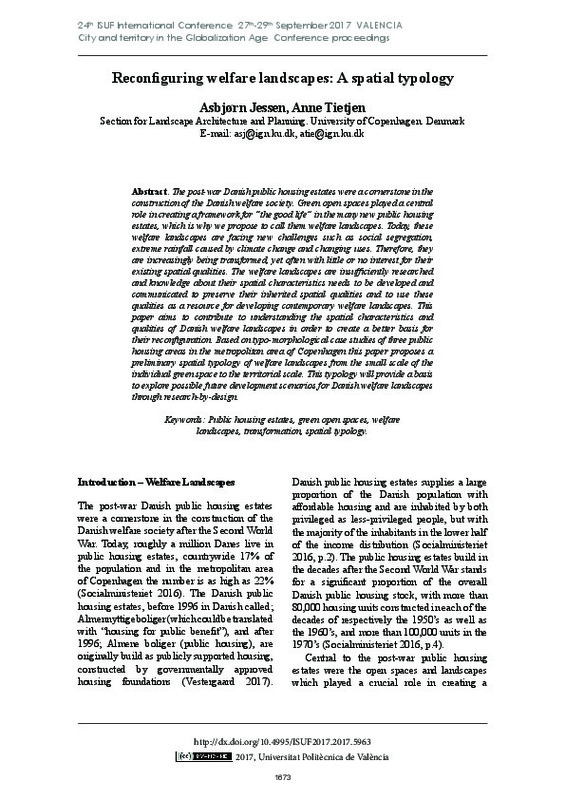JavaScript is disabled for your browser. Some features of this site may not work without it.
Buscar en RiuNet
Listar
Mi cuenta
Estadísticas
Ayuda RiuNet
Admin. UPV
Reconfiguring welfare landscapes: A spatial typology
Mostrar el registro sencillo del ítem
Ficheros en el ítem
| dc.contributor.author | Jessen, Asbjørn
|
es_ES |
| dc.contributor.author | Tietjen, Anne
|
es_ES |
| dc.date.accessioned | 2018-12-04T08:31:57Z | |
| dc.date.available | 2018-12-04T08:31:57Z | |
| dc.date.issued | 2018-04-20 | |
| dc.identifier.isbn | 9788490485743 | |
| dc.identifier.uri | http://hdl.handle.net/10251/113450 | |
| dc.description.abstract | [EN] The post-war Danish social housing estates were a cornerstone in the construction of the Danish welfare society. Green open spaces played a central role in creating a framework for “the good life” in the many new social housing estates, which is why we propose to call them welfare landscapes. Today, these welfare landscapes are facing new challenges such as social segregation, extreme rainfall caused by climate change and changing uses. Therefore, they are increasingly being transformed, yet often with little or no interest for their existing spatial qualities. The welfare landscapes are insufficiently researched and knowledge about their spatial characteristics needs to be developed and communicated to preserve their inherited spatial qualities and to use these qualities as a resource for developing contemporary welfare landscapes. This paper aims to contribute to understanding the spatial characteristics and qualities of Danish welfare landscapes in order to create a better basis for their reconfiguration. Based on typo-morphological case studies of three social housing areas in the metropolitan area of Copenhagen this paper proposes a preliminary spatial typology of welfare landscapes from the small scale of the individual green space to the territorial scale. This typology will provide a basis to explore possible future development scenarios for Danish welfare landscapes through research-by-design. | es_ES |
| dc.description.sponsorship | The studies carried out as part of this paper relates to A. Jessen’s ongoing PhD project titled Materialising Welfare Landscapes. The PhD is part of the larger research project Reconfiguring Welfare Landscapes at the University of Copenhagen, Section for Landscape Architecture and Planning, funded by the Danish Council for Independent Research. More about the Reconfiguring Welfare Landscapes research project: http://ign.ku.dk/english/research/landscapearchitecture-planning/landscape-architectureurbanism/research-project-1/ | es_ES |
| dc.format.extent | 11 | es_ES |
| dc.language | Inglés | es_ES |
| dc.publisher | Editorial Universitat Politècnica de València | es_ES |
| dc.relation.ispartof | 24th ISUF International Conference. Book of Papers | es_ES |
| dc.rights | Reconocimiento - No comercial - Sin obra derivada (by-nc-nd) | es_ES |
| dc.subject | Public housin estates | es_ES |
| dc.subject | Green open spaces | es_ES |
| dc.subject | Welfare landscapes | es_ES |
| dc.subject | Transformation | es_ES |
| dc.subject | Spatial typology | es_ES |
| dc.title | Reconfiguring welfare landscapes: A spatial typology | es_ES |
| dc.type | Capítulo de libro | es_ES |
| dc.type | Comunicación en congreso | es_ES |
| dc.identifier.doi | 10.4995/ISUF2017.2017.5963 | |
| dc.rights.accessRights | Abierto | es_ES |
| dc.description.bibliographicCitation | Jessen, A.; Tietjen, A. (2018). Reconfiguring welfare landscapes: A spatial typology. En 24th ISUF International Conference. Book of Papers. Editorial Universitat Politècnica de València. 1673-1683. https://doi.org/10.4995/ISUF2017.2017.5963 | es_ES |
| dc.description.accrualMethod | OCS | es_ES |
| dc.relation.conferencename | 24th ISUF 2017 - City and Territory in the Globalization Age | es_ES |
| dc.relation.conferencedate | Septiembre 27-29,2017 | es_ES |
| dc.relation.conferenceplace | Valencia, Spain | es_ES |
| dc.relation.publisherversion | http://ocs.editorial.upv.es/index.php/ISUF/ISUF2017/paper/view/5963 | es_ES |
| dc.description.upvformatpinicio | 1673 | es_ES |
| dc.description.upvformatpfin | 1683 | es_ES |
| dc.type.version | info:eu-repo/semantics/publishedVersion | es_ES |
| dc.relation.pasarela | OCS\5963 | es_ES |








